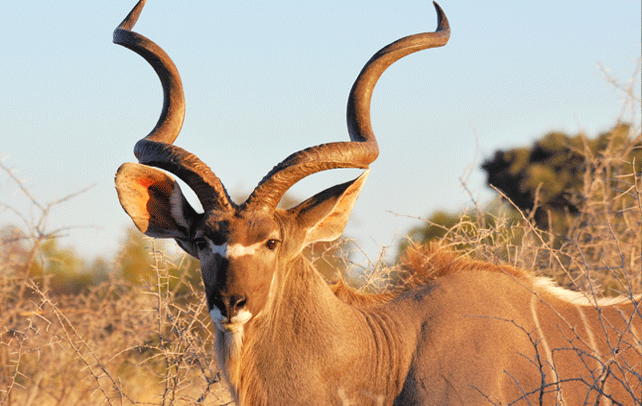Fun Facts About Kudu

Kudu, a very unique and beautiful animal, belongs to the group of antelopes. The range of kudus stretches from eastern to southern areas, and includes Ethiopia, Tanzania, Eritrea, Kenya, Zambia, Angola, Namibia, Botswana and Zimbabwe. Lesser kudu and greater kudu are the two species belonging to the kudu family. These species have almost similar features, except their sizes as lesser kudus are smaller than greater kudus. Kudus are diurnal that means they remain active in the day and sleep at night while during summers they usually prefer to stay hidden at only one area in the woodland. Areas with abundant supply of water like rocky hillsides and thick bushveld are their preferred places. Their presence around these areas invites predators like, lions, leopards, and hunting dogs. But, the whole herd is alerted when any of these senses an attack from the predators. Kudus don’t have enough stamina to run fast and for a long time, so they hide themselves in bushes and keep on standing still. Below subsection provides more facts on kudus. Read on.
Fast Facts
Scientific Name: Greater kudu: Tragelaphus strepsiceros; Lesser kudu: Tragelaphus imberbis
Kingdom: Animalia
Phylum: Chordata
Subphylum: Vertebrata
Class: Mammalia
Order: Artiodactyle
Family: Bovidae
Species: T. Strepsiceros
Diet: Leaves, grass, shoots, tubers, roots, and fruit
Size: Body: 120 to 245 cm; Tail: 30 to 55 cm
Weight: Male: 190 to 315 kg; Female: 120 to 210 kg
Life Span: Upto 20 years
Natural Habitat: Stony, sparsely to densely forested flat hilly and mountain country
Call: Gasp, grunt, cluck, humming
Age of Maturity: 1 to 2 years
Gestation Period: 8 months
Number of Offspring: 1
Interesting And Fun Facts About Kudu
- Kudus have narrow body with long legs and their outer coat ranges from brownish/bluish grey to reddish brown. They have four to twelve white bands on their torso.
- Head is usually darker than the rest of the body and often the chevron of white hair can be seen on their forehead.
- Both greater and lesser males of kudu kingdom have stripes and spots on the body. They also have mane going from head to shoulders.
- The lesser kudus, found in the savannahs of easternAfrica, have upto fifteen stripes on the body. Long mane, one of the best features of greater kudus, is absent in lesser kudus.
- Both the species of kudus have been further classified into subspecies. Grubb (imberbis) andGroves(australis) are the subspecies of lesser kudus while the recognizable subspecies of greater kudus are T. s. strepsiceros, T. s. chora, and T. s. cottoni.
- Kudus are capable of jumping as high as seven feet. In order to save themselves from enemies or possible danger, they jump and hide behind the bushes.
- Although lesser kudus are smaller in size as compared to the greater kudus but they can run faster than greatest kudus.
- It has the second largest horns in artiodactyl order which can be as long as 187 cm.
- Males often have spiral horns with almost 2 or 2 ½ beautiful twists while females don’t have horns at all.
- Size of males is double the size of females and the female might bite when required.
- Females can keep running for many miles without stopping, but they spend more than one minute while resting.
- Since kudus are very good kickers, they can break a wild dog’s or jackal’s neck.
- The mysterious colouring and markings on their bodies protect kudus by hiding them in tall grass or bushes. In case of threat, they usually stand still and become very difficult to spot.
- Kudus don’t generally wander to large areas; they limit themselves to a smaller range in order to protect themselves. But sometimes, they may go to the open regions in case there is a shortage of food.
- Female kudus usually live in a herd of 6-20, consisting of females and young ones whereas males are solitary. But sometimes, they may form a herd of maximum four kudus.
- Male kudus show their dominance by standing next to another and the one with larger body is considered as the leader.
- Many a times, the male kudus use their horns to fight with other male kudus, but sometimes these horns get twisted into each other and it gets very difficult to detangle them. Consequently, they die out of starvation or get killed by predators.
- Kudus are threatened by hyenas, lions, leopards, eagles, pythons, and Cheetahs. Eagles and cheetahs often prey over young ones and females because they can’t take over fully grown males.
- Females leave the herd at the time of birth, in order to take care of the young ones. It leaves the young one hidden in the bushes for four to five weeks and then returns to nurse it. After five months the calf starts accompanying its mother and then joins the group with its mother.
- These antelopes produce the loudest sounds in the form of gruff bark.
- Jews make horns, known as shofras, out of their horns that are blown at their ritual Rosh Hashanah. Their horns are also used for making trophies.
- Some African tribes hunt them for their meat and sometimes kudus are killed because they are considered as crop damaging beasts.
- Kudus get both positive and negative experiences from the human contact. Some humans believe it to be a sacred animal and worship it while others hunt it for its horns and meat.
- The meat of kudu is very dry and lean and therefore it should be prepared carefully. The low fat content makes it one of the healthy meats.
- The rinderpest virus, the deadly virus found in livestock, once reduced the population of kudus in eastAfrica, but the virus was eradicated immediately with the help of a vaccination program.
- Kudus are highly prone to rabies too. These infected kudus have been found entering human settlements during the time of extended drought.









